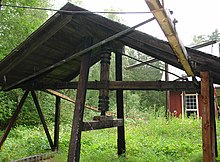Polhemsrad
The Polhemsrad ( Swedish Polhemshjulet ) is a Kunstrad that in Norberg in the Swedish mine region Berg layers 1876 to 1920 via a synthetic linkage drive pump for the drainage of mines.
history
The Polhemsrad was built in 1876 to designs by the Swedish scientist and inventor Christopher Polhem (1661–1751). It drove a 1 km long horizontal artificial linkage , which in turn moved the pumps in the Kärrgruvan , an ore mine. The pumps were called Svinryggen (pork loin) because of their appearance .
Artificial rods have been used in mining since the Middle Ages in order to be able to use the driving force of the water in more distant places. Polhem improved the linkage by suspending both linkage parts on the left and right via common levers on vertical axes, which reduced transmission losses and thus improved the efficiency of the system. To change the direction of the power transmission, Polhem developed the so-called "turning point", which works like a horizontal artificial cross.
Although electricity was already available in Norberg in 1897, the Polhemsrad was still in use until 1920. It has now been given a protective house. The key can be borrowed from a nearby small supermarket for sightseeing.
description
water wheel
The overshot waterwheel with a diameter of 15 m - it is one of the largest in Sweden - was fed from the lake Bålsjön via a 3 km long artificial moat. The system, built on a slope, was fed from the canal via a channel across the waterwheel. The bike was built into the slope, which allows a low water drainage, the linkage is guided uphill.
141 iron shovel boards with a width of 105 cm are mounted on the wheel circumference of 47 m. The output takes place via two curved pins on the wheel sides. With a crank radius of 90 cm, the rod lift is 180 cm.
Linkage
The opposing drive rods on the wheel axle are coupled to an intermediate bearing by a lever with the same arm lengths. The force is transmitted via band-shaped tie bars, which are suspended from supporting pillars and move back and forth with the turn of the crank. The linkage then passed the force on to the pit 1 km away.
Turning point
To change direction, so-called "turning points" were used, vertically mounted wheel rims to which two pairs of connecting rods were attached offset. A turning point has been preserved and accessible at some distance from the water wheel.
Web links
- ekomuseum.se - Destination: Polhemshjulet - English
- ekomuseum.se (PDF; 46 kB) - English
Individual evidence
- ↑ a b ekomuseum.se ( Memento of the original from August 9, 2010 in the Internet Archive ) Info: The archive link was inserted automatically and has not yet been checked. Please check the original and archive link according to the instructions and then remove this notice.
- ↑ Information board on the Polhemsrad
Coordinates: 60 ° 5 ′ 35 " N , 15 ° 55 ′ 47" E




